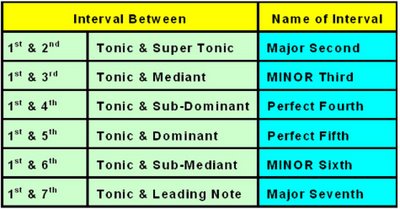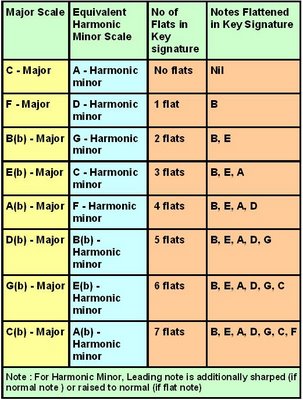Hi All,
We were so involved in our discussions of Major Scales so far, so that, if I once again say that the pattern of Major Scale is
( Whole + Whole + Semi ) + Whole + (Whole + Whole + Semi )
you will be irritated a little bit…! ?
Anyway, that’s a good sign…..indicating that…. your brain has registered the Major Scale strongly in your mind !
What about some other pattern…?
OK.. …WCM has another pattern to entertain you…! Sorry….its make you mooooody……!
Anyway let us see what is that so called "other" pattern !
One more time let us recall the C-Major…..Its all white keys of the keyboard …isn’t it ?
You may recall all those IR song examples I gave you for the Major scales…explaining the jolly mood of Major Scale.
Now I am going to suggest one small modification of using a black note in the C-Major…that is instead of the third white key “E”, use E-Flat .
(you will not call that black key as D-Sharp now…because…you know the reason…and I know you are already wiser now to call that as E-Flat only…..!)
Certainly we have upset the Major pattern……! Aren’t we…!
What is the new pattern now?
C-D- E(b) -F-G-A-B-C
Absolutely it cannot be a Major Scale…. Do you agree that….?
If you want to feel that change, try to play the normal C-Major Scale first slowly.. and then try to play this new scale….! Slowly and repeatedly………..!
You will find a hell lot of difference in quality of the scale…!
Major has lost its jovial nature…! Now become suddenly moody…just the change from E to E-flat makes that….!
Some examples of IR song that can follow this new pattern…are :
“Dhoorathil Naan kanda “ (Nizhalgal)…
” Pon Vaanam Panner Thoovudhu..” (Indru Nee Naalai Naan)
“Adhikaalai Nilave..” (Urudhi Mozhi…)
“Solai Poovil “ (Vellai Roja..)
“Muthamizh Kaviye Varuga…” (Dharmathin Thalaivan)
Our Carnatic friends would have identified this new pattern as “Gowri Manohari “ Raagam!
Anyway, our journey has not ended. We have entered …only entered..the MINOR Zone…!
To authentically finish off our change process, we have to do one more change…!
Let us effect that change..!
Again change another white note "A" to "A-flat"….!
Now this change makes it further deadlier pathetic and heavily moody..!
You will recognize that, if you play this sequence,
C-D- E(b) -F-G- A(b) -B-C
(back and forth..any combination of these notes…on and on and on…)
and correlate with the following IR songs :
“Kaatre..Endhan Geetham…” (Johnny)
“Nee dhaana Nee dhana..Nenje Nee dhaana (Thaalatu Paada Vaa)
“Keeravaaani..” (Paadum Paravaigal.) (Anveshana…)
“Malargalile….. Aaraadhanai…..” (Karumbu Vil)
“Thanga Changili…” (Thooral Ninnu Pochu..)
“Nandhavana Kuyile..” (Ponnu Veetukkaaran)
“Aayiram Kodi…” (Kariasa kaattu Poove..)
“Pen Poove…. Pen Poove….”
“Thedum Dheivam Neril Vandhadhu…” (Kazhugu)
“Deiveega Raagam…Thevittaadha Paadal...” (Ullaasa Paravaigal..)
You can automatically feel the heaviness of this pattern which makes a deep impact inside you…!
I can bet that, whatever may be the lyrics and situations, if you hear these tunes alone also..….these will make you internally cry….!
An instant melancholic situation simulator !
Anyway, that’s what the so called Minor Scale is all about
(just namesake that’s minor, but impact wise well above major).
(Our Carnatic friends can recognize this as Keeravaani Raagam)
Try this pattern on key board and feel that…
Play alternatively with C-Major and this C-Minor….
and involve yourself in the visual and hearing impact it makes on you…
I want you to drown in this Minor ocean…!
Listen to those songs also….!
(Those who can afford and have some taste for Hindusthaani Music, please try and get Pandit Shiv kumar Sharma’s CD of Santoor recital in Raag Keeravani.. and listen it…..! )
I will leave you in this deeeeeepppp meditative moooood…..!
Till such time I again catch you ….!
We were so involved in our discussions of Major Scales so far, so that, if I once again say that the pattern of Major Scale is
( Whole + Whole + Semi ) + Whole + (Whole + Whole + Semi )
you will be irritated a little bit…! ?
Anyway, that’s a good sign…..indicating that…. your brain has registered the Major Scale strongly in your mind !
What about some other pattern…?
OK.. …WCM has another pattern to entertain you…! Sorry….its make you mooooody……!
Anyway let us see what is that so called "other" pattern !
One more time let us recall the C-Major…..Its all white keys of the keyboard …isn’t it ?
You may recall all those IR song examples I gave you for the Major scales…explaining the jolly mood of Major Scale.
Now I am going to suggest one small modification of using a black note in the C-Major…that is instead of the third white key “E”, use E-Flat .
(you will not call that black key as D-Sharp now…because…you know the reason…and I know you are already wiser now to call that as E-Flat only…..!)
Certainly we have upset the Major pattern……! Aren’t we…!
What is the new pattern now?
C-D- E(b) -F-G-A-B-C
Absolutely it cannot be a Major Scale…. Do you agree that….?
If you want to feel that change, try to play the normal C-Major Scale first slowly.. and then try to play this new scale….! Slowly and repeatedly………..!
You will find a hell lot of difference in quality of the scale…!
Major has lost its jovial nature…! Now become suddenly moody…just the change from E to E-flat makes that….!
Some examples of IR song that can follow this new pattern…are :
“Dhoorathil Naan kanda “ (Nizhalgal)…
” Pon Vaanam Panner Thoovudhu..” (Indru Nee Naalai Naan)
“Adhikaalai Nilave..” (Urudhi Mozhi…)
“Solai Poovil “ (Vellai Roja..)
“Muthamizh Kaviye Varuga…” (Dharmathin Thalaivan)
Our Carnatic friends would have identified this new pattern as “Gowri Manohari “ Raagam!
Anyway, our journey has not ended. We have entered …only entered..the MINOR Zone…!
To authentically finish off our change process, we have to do one more change…!
Let us effect that change..!
Again change another white note "A" to "A-flat"….!
Now this change makes it further deadlier pathetic and heavily moody..!
You will recognize that, if you play this sequence,
C-D- E(b) -F-G- A(b) -B-C
(back and forth..any combination of these notes…on and on and on…)
and correlate with the following IR songs :
“Kaatre..Endhan Geetham…” (Johnny)
“Nee dhaana Nee dhana..Nenje Nee dhaana (Thaalatu Paada Vaa)
“Keeravaaani..” (Paadum Paravaigal.) (Anveshana…)
“Malargalile….. Aaraadhanai…..” (Karumbu Vil)
“Thanga Changili…” (Thooral Ninnu Pochu..)
“Nandhavana Kuyile..” (Ponnu Veetukkaaran)
“Aayiram Kodi…” (Kariasa kaattu Poove..)
“Pen Poove…. Pen Poove….”
“Thedum Dheivam Neril Vandhadhu…” (Kazhugu)
“Deiveega Raagam…Thevittaadha Paadal...” (Ullaasa Paravaigal..)
You can automatically feel the heaviness of this pattern which makes a deep impact inside you…!
I can bet that, whatever may be the lyrics and situations, if you hear these tunes alone also..….these will make you internally cry….!
An instant melancholic situation simulator !
Anyway, that’s what the so called Minor Scale is all about
(just namesake that’s minor, but impact wise well above major).
(Our Carnatic friends can recognize this as Keeravaani Raagam)
Try this pattern on key board and feel that…
Play alternatively with C-Major and this C-Minor….
and involve yourself in the visual and hearing impact it makes on you…
I want you to drown in this Minor ocean…!
Listen to those songs also….!
(Those who can afford and have some taste for Hindusthaani Music, please try and get Pandit Shiv kumar Sharma’s CD of Santoor recital in Raag Keeravani.. and listen it…..! )
I will leave you in this deeeeeepppp meditative moooood…..!
Till such time I again catch you ….!




